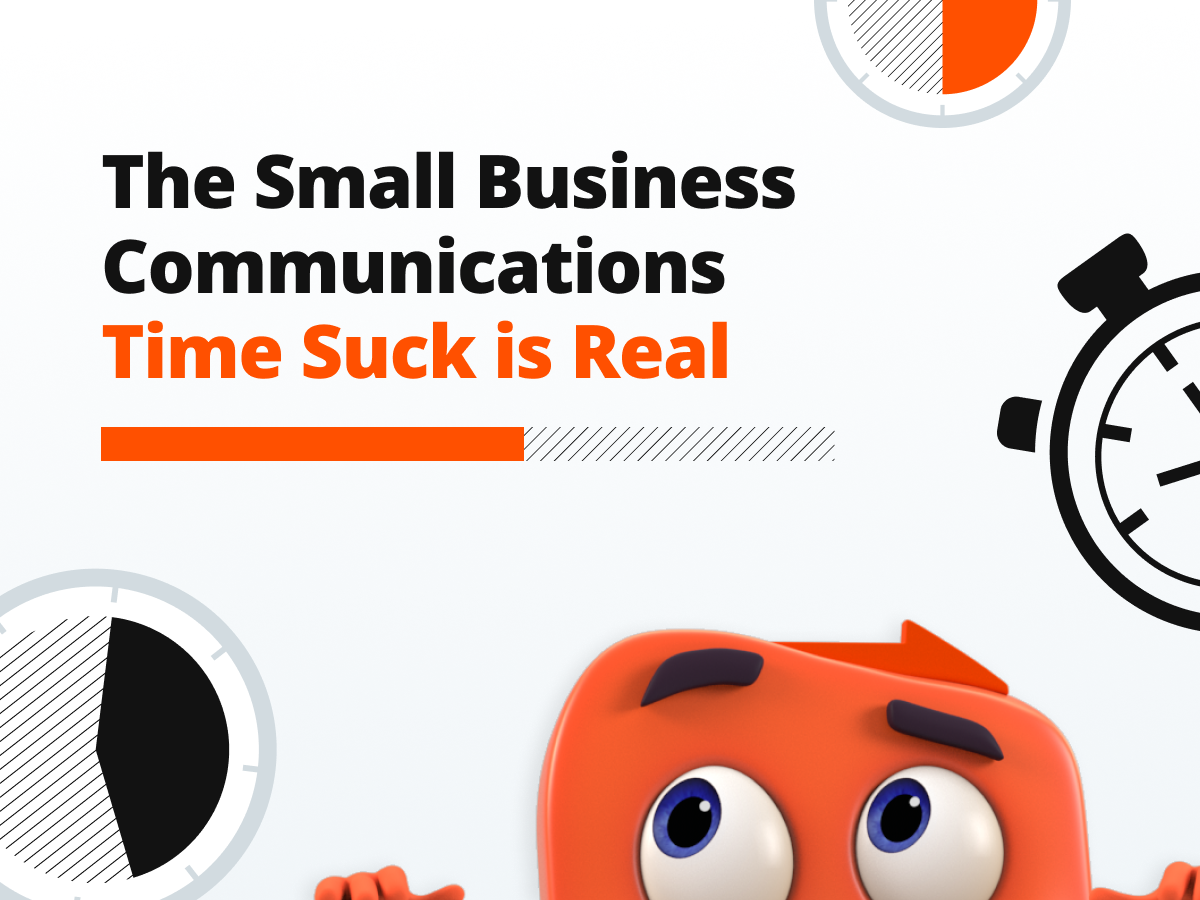Have you ever yelled at someone for not using their blinker? I have – and not just because I drive in Boston.
Car blinkers are one of the most basic forms of proactive communication. By using them, you’re giving others a clear heads-up that you’re about to make a turn (into three lanes of oncoming traffic).
In business, proactive communication is anticipating customer needs and reaching out before problems arise, as opposed to reactive communication, which addresses issues only after they occur.

Improve Your Communication With Command Center
Try FreeProactive communication can set your business apart from competitors. But, while it’s easy to ask employees to be more proactive, explaining what that means and why it matters is a little more complex.
In this post, we’ll define proactive communication, explain why it’s so important to small businesses, and discuss how to implement it successfully at your company.
What is proactive communication?
Proactive communication is the practice of anticipating customer problems and reaching out with solutions before they occur. Planning ahead, predicting potential challenges, and creating an open dialogue will build trust and transparency with customers and create a better brand experience.
Proactive communication has four phases:
- Anticipation (Foreseeing potential concerns or issues)
- Preparation (Developing solutions and response ideas)
- Engagement (Regularly updating people on the potential issues)
- Transparency (Sharing information honestly and clearly to avoid mistrust)
Even the best businesses experience errors, outages, and other mishaps. A proactive communication strategy safeguards your online reputation and fosters trust with your customer base.
Let’s explore a few other benefits in the section below.
Why is proactive communication important?
All businesses benefit from effective communication, but proactive communication is especially vital for small business owners. By implementing proactive communication strategies, your business can:
- Build trust and loyalty with customers. Trust is the most important reason for using proactive communication. It’s a key component of any professional (or personal) relationship, often leading to repeat sales.
- Improve customer satisfaction. By anticipating customer needs, you’ll set your business apart from competitors who only react to complaints. You’ll show customers you care enough about their needs and satisfaction to reach out to them.
- Prevent issues before they escalate. By identifying and addressing issues early, you’ll avoid damaging your reputation and customer relationships. No one expects perfection, but they want to know that you know what’s happening and are seeking a solution.
- Improve employee morale. Educate your team on company policies, goals, news, and expectations. Let them know they’re welcome to provide feedback because it will make your team feel informed and valued.
Now that we’ve made the case for proactive communication, let’s look at some examples.
Proactive Communication in the Workplace
Here are some ways you can use proactive communication within an office or workplace:
1. Reporting a Technical Problem
If you notice something wrong with your business, your customers will notice it, too. It could be a glitch in your product, a downed phone system, or a slow website. These issues impact customer experience and create negative perceptions of your brand – like how the CrowdStrike outage affected Delta’s operating system last week.
Technology isn’t perfect, and sometimes it breaks, leaving your business unable to handle frustrated customers. Don’t panic. Instead, gather information and determine the source of the issue. Try to determine the impact on customers and what alternative solutions are available.
Next, share the information you gathered — even if you don’t know the cause yet. It’s important to let customers know that you’re aware of the issue and are working to solve it as quickly as possible.
Here’s where social media can be helpful. You can use it to share real-time updates with your customers if a product or service breaks. You can also publish updates on your blog, like when you release a new fix for a bug or share PR news.
2. Providing Project Updates
If you manage an ongoing project with a customer or client, you can proactively send them updates at each milestone or achievement. You can also notify them if you hit a roadblock or experience delays. This information keeps people in the loop and assures them that you are still working on their issue.
Here’s where email automation can be handy. You can use it to automatically send messages to customers who haven’t spoken to you in a while. It saves you time from having to write out the message, and it ensures you always follow up with customers, even if an email slips through the cracks.
3. Collecting Customer Feedback
Customer feedback helps you understand what is and isn’t working for your business. Asking customers to complete a survey will give you some great ideas for improving your products and services.
Here’s a piece of proactive communication that I received earlier this week. It was an email asking me to review an event that I attended.

I definitely wouldn’t have discovered this survey on my own, and the feedback I provided will help the company host a better event next year. It’s a great example of how proactive communication benefits buyers and sellers.
4. Celebrating Good News
Proactive communication doesn’t just have to be about problem-solving. You can also use it to celebrate big wins and achievements at your company, too. It’s a great way to leverage reputation marketing to increase brand awareness and improve the overall perception of your brand.
One example is a company award. If you win one, let customers know via email, social media, and your website. Most won’t seek out this information on their own, so you have to be proactive. For instance, when Thryv was recognized by G2 last year, we published this page and created content to share on social media.

5. Engaging Followers on Social Media
Some businesses only use social media to react to customers (addressing angry comments and complaints), but it’s also a great channel for proactive communication. You can post updates like this one that announce new promotions or products for your company.

This type of communication is great for re-engaging existing customers. It reminds them about your brand and gives them a reason to return to your business.
Ready to get started with proactive communication? Let’s review the most effective strategies you can adopt for your small business.

The Small Business Communications Time Suck is Real
The right communication is vital to your success as a small business. But sometimes it can eat up too much of your time. We’ll show you how to streamline communications in this free guide.
Proactive Communication Strategies for SMBs
The “best” strategies vary based on your company’s needs, but these can be adapted and used for any type of business.
1. Automated Email Campaigns & Newsletters
Automated email campaigns inform customers about special offers, deals, services, and new features for your products. A newsletter may also be the best way to keep customers informed about company news and updates.
Here’s an automation that any website should have. When someone completes a form, you send an email welcoming them to your business. The email has resources and articles for new customers to navigate your products and services.

With this setup, you don’t have to write the email or remember to send it. The AI tool does this every time the customer submits a form.
2. Crisis Communication Plans
When we think about proactive communication, most of us default to a crisis or a problem that hurts your business’s reputation. While you should prevent crises at all costs, sometimes they’re unavoidable, and you should know how to handle them.
When it comes to crisis management, proactive communication means taking control of the narrative. Let customers know the situation (via email, phone, and social media) and explain what your business is doing to solve it. Apologize if appropriate, and be prepared to handle conversations on a company-wide scale.
Remember, resolving a crisis may require several steps. Consider using multiple communication channels to get your message across.
3. Predictive Customer Service
Some proactive communication strategies take time to implement — but they’re worth it. For example, you can study customer inquiries and complaints, and use that data to predict issues before they occur. Then, if something happens, you’ll be ready to address it before it escalates.
Subscriptions are a great example. If you have a CRM, you can track subscriptions that are about to expire. Then, you can contact customers before their expiration date to remind them to renew.
Here’s a message I received from a company after my free trial had expired:

4. Content Marketing
Content marketing is one of the most effective ways to promote your business. Content is any physical or digital asset that supports your brand, including videos, social media, websites, print ads, and more.
Content can serve several purposes. It can promote your products and services, educate your audience, or share updates about your brand.
If you’re looking for an example, this blog is a good one. We use it to teach people how to run their small businesses and feature our products on it.
5. Social Media
As discussed earlier, you can use social media for proactive and reactive communication.
For proactive communication, it’s important to monitor your social media channels for mentions of your business and share the good things people say about your company. Engage with followers who comment and review your products and services. And, of course, respond to messages quickly to ensure customers get a response in a timely manner.
Pro Tip: Social media management tools can help you monitor social platforms for mentions of your business.
6. Customer Onboarding
Customer onboarding is another instance where proactive communication can improve customer experience. Onboarding is when a new customer joins your business and learns how to use your products and services for the first time. During onboarding, they’ll likely have questions about how to get set up and what they can do with your product.
A simple welcome email, how-to video, or other guide will ensure they understand how to get the most out of what they’ve purchased. It reduces the chance of abandonment because it shows people how to use your product or service immediately. That way, they’ll see results right away and be happier with your business.
7. Employee Communication
Your employees are valuable sources of information. If you regularly hold meetings and provide updates on performance, you’ll gain valuable feedback from people who are truly invested in your business.
At Thryv, we host an internal company meeting once a month where we discuss a number of things our employees should be aware of that month. We even have a fun “news show” that packages this information into a brief video clip. Employees obtain more insight into what’s going on at the business, which helps them become more aligned on goals and more productive for the company.
Thryv isn’t the only company that uses proactive communication. Let’s look at three brands that do an excellent job of keeping their customers informed.
3 Examples of Proactive Communication
1. AT&T
Some AT&T customers experience “sticker shock” when they receive their first monthly bill. Since they combined their phone service with wifi, they might not understand why their bill seems high.
To avoid confusion (and frustration), AT&T sends customers this video explaining their first bill. It outlines how to access their bill and what each part of the invoice means.
Not only does this help customers find answers, but it reduces the number of service calls for the business. That helps AT&T respond to calls faster because they have fewer people to respond to.
2. Amazon
Amazon knows its customers have questions about their delivery dates, and it notifies them in advance of delays. When a delay occurs, Amazon provides the option to choose a new delivery date or lets the customer know how to request a refund if a new date doesn’t work for them.

Amazon understands how important delivery times are for its customers, so it leverages proactive communication to solve complaints before customers even have a chance to voice them.
3. Caterpillar
Caterpillar helps customers maintain their vehicles over time with self-service resources like blogs and online manuals. These documents are publicly available when customers need help so they can work on their equipment without contacting the company directly.

Caterpillar also sells people “maintenance kits,” which include products and services for maintaining vehicles. Caterpillar knows these customers will need these products eventually, so they save them time by selling them in a convenient kit. It’s a proactive way to keep customers happy and upsell them at the same time.
Creating a Proactive Communication Strategy
Proactive communication goes beyond simple strategy — it’s actually a mindset that helps you anticipate potential challenges and growth opportunities. For small business owners, the benefits are invaluable.
Develop a robust communication plan — and take advantage of technology where possible. Tools like shared inboxes, social media management software, and team chat can help you stay ahead of the curve and make it easy to connect with customers.

The Small Business Communications Time Suck is Real
The right communication is vital to your success as a small business. But sometimes it can eat up too much of your time. We’ll show you how to streamline communications in this free guide.





